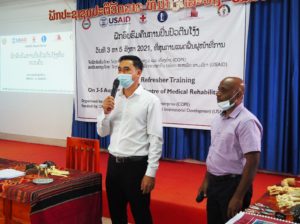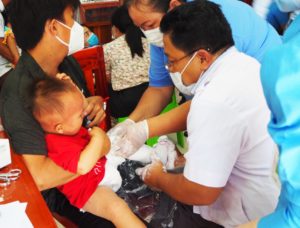
“It is a good opportunity for us [rehabilitation health professionals] to refresh our knowledge and skills on clubfoot treatment. During the training, after practicing on a clubfoot rubber mould, we had the chance to practice clubfoot manipulation and casting on babies in real time. I think the most important part of the training for us was to refresh our skills on how to put our fingers at the exact place to correct the foot deformities.” – Mr. Phayabseng Vilayvanh, participant from the Provincial Rehabilitation Sub Center (PRSC), Savannakhet Province.
More than 200 babies are born with clubfoot every year in Laos. Boys are twice more likely to have clubfoot than girls and 50% of the babies with clubfoot have both feet affected. If properly treated in the first weeks after birth, the clubfoot deformity will disappear at the time the toddler starts walking.
Correcting clubfoot deformities of a newborn baby using the Ponseti method requires a lot of experience and delicate hand skills. For the therapists, positioning their fingers at the right place on the baby’s foot is crucial to achieve optimal clubfoot correction. The refresher training provided rehabilitation professionals with a better understanding of the entire protocol of treatment including serial casting, bracing, and follow-up, but also allowed them to practice and in prove their hand skills on real babies.

From 3 to 5 August 2021, USAID Okard supported COPE to conduct a refresher training on clubfoot treatment to Lao national rehabilitation health professionals from the Centre of Medical Rehabilitation and four Provincial Rehabilitation Sub Centers (4 PRSCs) from Savannakhet, Xieng Khouang, Champasack, and Luangprabang Provinces.
With refreshed knowledge and skills, USAID Okard and COPE are confident that all babies born with clubfoot and treated by the professionals at CMR and PRSCs, will enjoy an active and happy life.
USAID Okard, funded by USAID and implemented by World Education Inc,. improves access to quality healthcare and economic opportunities for persons with disabilities, and supports design and implementation of disabilities inclusive policies.
